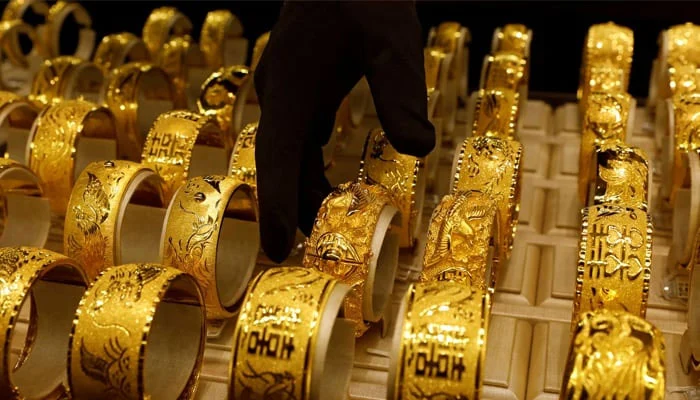- Bullion extends record-making run as rupee devaluation worsens.
- Gold in Pakistan overcost by Rs5,000 per tola vs Dubai market.
- Dealers think gold to remain unstoppable in the near term.
Gold prices in Pakistan roared to a new record high Monday, while the rupee continued to whimper versus the dollar after being thrown to the mercy of the unruly market forces to coax the International Monetary Fund (IMF) into unlocking a stalemated loan, dealers said.
According to All-Pakistan Sarafa Gems and Jewellers Association (APSGJA), the price of gold (24 carats) increased by Rs1,500 per tola and Rs1,286 per 10 grams to settle at Rs210,500 per tola and Rs180,470 per 10 grams, respectively.
The jewellers’ body also said that local gold was “overcost” by Rs5,000 per tola in Pakistan, compared to the Dubai bullion market.
Dealers, who were already eyeing the 200,000+ per tola rate since the current price hike spree, cited record-breaking rupee devaluation and a steep decline in the foreign exchange reserves in the country as major factors contributing towards the massive price hike in the bullion market.
Investors were, however, purchasing only gold bars, not jewellery, which had not only reduced goldsmiths’ profit margins but the labour force was also at the stake of losing jobs, as jewellery makers were moving towards other professions in absence of work, The News reported on Friday.
“There was a decline in purchasing power of the people as more people now use artificial jewellery,” a goldsmith said, adding that the majority of the gold makers are also moving towards artificial jewellery.
Gold in the international market edged up on a weaker dollar, as investor attention moved to several central bank meetings this week for more clarity on their rate hike strategies, with the key focus on the US Federal Reserve.
Spot gold gained 0.1% to $1,928.36 per ounce.
“Gold is easing away from a nine-month high as the US dollar and yields stabilise, as markets eagerly await the Fed’s latest policy guidance,” said Han Tan, chief market analyst at Exinity.
The dollar was 0.2% lower, making bullion, which is priced in the US currency, more attractive for customers holding other currencies.
Market participants widely expect a 25-basis-point (bps) interest rate increase from the US central bank at the end of its two-day policy meeting on February 1.
Expectations are for a slowdown in Fed rate hikes after economic data showed signs of cooling U.S. inflation, while US consumer spending fell for a second-straight month in December, putting the economy on a lower growth path heading into 2023.
Gold, which pays no interest, tends to benefit when interest rates are low as it reduces the opportunity cost of holding bullion.

 Latest News13 hours ago
Latest News13 hours ago
 Latest News13 hours ago
Latest News13 hours ago
 Latest News12 hours ago
Latest News12 hours ago
 Latest News12 hours ago
Latest News12 hours ago
 Latest News12 hours ago
Latest News12 hours ago
 Latest News13 hours ago
Latest News13 hours ago
 Business13 hours ago
Business13 hours ago
 Latest News13 hours ago
Latest News13 hours ago





















